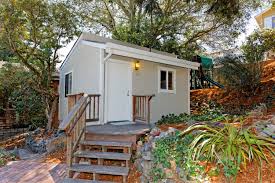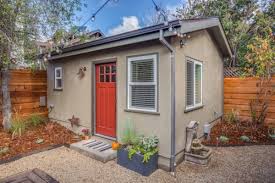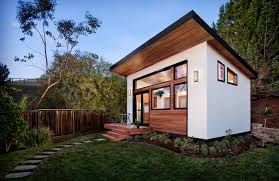 The combination of rising home prices, a shortage of available homes and a new California state ordinance for “Accessory Dwelling Units – ADUs” may lead to the resurrection of a robust inventory of granny units, also known as ADUs. ADUs are nothing new; they have been built for centuries but are not all that well known – most people call them granny units. However, due to strict local regulations like parking restrictions, cost prohibitive permitting costs, feasibility of connecting to municipal services, i.e., sewer, water, electricity, residents have historically had significant challenges implementing these buildings onto their properties. However, there is now a move afoot to simplify and streamline the process of getting ADUs or granny units installed to reduce the chronic housing shortage in certain geographical locations, especially Silicon Valley.
The combination of rising home prices, a shortage of available homes and a new California state ordinance for “Accessory Dwelling Units – ADUs” may lead to the resurrection of a robust inventory of granny units, also known as ADUs. ADUs are nothing new; they have been built for centuries but are not all that well known – most people call them granny units. However, due to strict local regulations like parking restrictions, cost prohibitive permitting costs, feasibility of connecting to municipal services, i.e., sewer, water, electricity, residents have historically had significant challenges implementing these buildings onto their properties. However, there is now a move afoot to simplify and streamline the process of getting ADUs or granny units installed to reduce the chronic housing shortage in certain geographical locations, especially Silicon Valley.
 The new state ordinance loosens up restrictions on ADUs and actually makes them more of an attractive option for homeowners. As more Silicon Valley real estate owners notice the value of these accessory dwelling units, California’s housing crisis could slowly start becoming manageable again. We are seeing a move within the marketplace towards smaller homes, vertical homes, tiny homes, granny units, and accessory dwelling units all becoming more and more attractive to property owners, renters, and municipalities.
The new state ordinance loosens up restrictions on ADUs and actually makes them more of an attractive option for homeowners. As more Silicon Valley real estate owners notice the value of these accessory dwelling units, California’s housing crisis could slowly start becoming manageable again. We are seeing a move within the marketplace towards smaller homes, vertical homes, tiny homes, granny units, and accessory dwelling units all becoming more and more attractive to property owners, renters, and municipalities.
How an ADU Can Help Homeowners?
 With the cost of owning a home so high in many cities throughout California, homeowners see ADUs as a way to help pay their mortgage and create some additional income. More homeowners are building ADUs to rent out to people seeking alternative housing, which in turn helps the housing crisis by providing people with affordable homes across the state. The win-win situation created by these affordable housing units could cause a spike in the number built.
With the cost of owning a home so high in many cities throughout California, homeowners see ADUs as a way to help pay their mortgage and create some additional income. More homeowners are building ADUs to rent out to people seeking alternative housing, which in turn helps the housing crisis by providing people with affordable homes across the state. The win-win situation created by these affordable housing units could cause a spike in the number built.
 Housing Shortages Can be a Boost to ADU Growth
Housing Shortages Can be a Boost to ADU Growth
Different cities are passing their own ordinances to piggyback off the statewide ordinance. For example, the City of San Jose has reduced the size of the required lot to build a granny unit, increased the maximum size of the structure by 100 square feet and eliminated previously strict parking requirements. Combining these attractive changes with the need for additional housing will only help the housing market. If you look at San Jose alone, which includes more than 175,000 homes, there would be 17,500 additional units if only 10 percent of the residents decided to build an ADU.
 Switching Square Footage for Affordable Housing Is Attractive
Switching Square Footage for Affordable Housing Is Attractive
Many residents in California are no longer concerned about having a large home with a significant amount of space. The average homeowner would rather save their money by finding affordable homes, even if it means sacrificing square footage. This is especially true for individuals living alone or those with small families. As more ADUs are built by single-family homeowners, we could begin seeing the housing market return to normal levels eventually. This would be a welcoming sign for Silicon Valley real estate owners, as well as the real estate market in general throughout the state of California.
Need Help with Making a Decision on an ADU for Your Property?
Many answers are starting to surface as they relate to ADUs in California, but there are still plenty of questions as well. Whether you’re a homeowner considering building an ADU on your property or you’re looking for affordable housing, contact us at Esquire Property Management Group. We have the answer to every question you have to ensure you put yourself in the best situation whether its consulting on development or managing your current properties.
David currently is the broker/owner of several real estate related businesses which manage and maintain 300+ client properties on the San Francisco Peninsula.
Trust, transparency, and performance guarantees are the foundation of these businesses. David challenges anyone to find a PM professional that offers services similar - extensive education, customer service, and performance guarantees.
David also provides consulting for his clients on property development feasibility, construction, and complex real estate transactions.
David has authored a published law review article, three real estate books, and over 150+ real estate blog articles.
- “Wildfires, Insurance & Mortgages: Will Your Home Survive the Financial Aftermath?” - March 3, 2025
- What’s Driving California’s Commercial Real Estate Shakeup? - February 27, 2025
- Critical Issues in Triple Net Leases Investors Should Know - February 14, 2025

